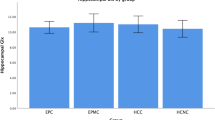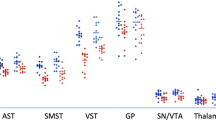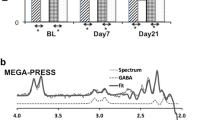Abstract
Most drugs of abuse lead to a general blunting of dopamine release in the chronic phase of dependence, which contributes to poor outcome. To test whether cannabis dependence is associated with a similar dopaminergic deficit, we examined striatal and extrastriatal dopamine release in severely cannabis-dependent participants (CD), free of any comorbid conditions, including nicotine use. Eleven CD and 12 healthy controls (HC) completed two positron emission tomography scans with [11C]-(+)-PHNO, before and after oral administration of d-amphetamine. CD stayed inpatient for 5–7 days prior to the scans to standardize abstinence. Magnetic resonance spectroscopy (MRS) measures of glutamate in the striatum and hippocampus were obtained in the same subjects. Percent change in [11C]-(+)-PHNO-binding potential (ΔBPND) was compared between groups and correlations with MRS glutamate, subclinical psychopathological and neurocognitive parameters were examined. CD had significantly lower ΔBPND in the striatum (P=0.002, effect size (ES)=1.48), including the associative striatum (P=0.003, ES=1.39), sensorimotor striatum (P=0.003, ES=1.41) and the pallidus (P=0.012, ES=1.16). Lower dopamine release in the associative striatum correlated with inattention and negative symptoms in CD, and with poorer working memory and probabilistic category learning performance in both CD and HC. No relationships to MRS glutamate and amphetamine-induced subclinical positive symptoms were detected. In conclusion, this study provides evidence that severe cannabis dependence—without the confounds of any comorbidity—is associated with a deficit in striatal dopamine release. This deficit extends to other extrastriatal areas and predicts subclinical psychopathology.
This is a preview of subscription content, access via your institution
Access options
Subscribe to this journal
Receive 12 print issues and online access
$259.00 per year
only $21.58 per issue
Buy this article
- Purchase on Springer Link
- Instant access to full article PDF
Prices may be subject to local taxes which are calculated during checkout



Similar content being viewed by others
References
Association AP Diagnostic and Statistical Manual of Mental Disorders: DSM-5, 5th ed. American Psychiatric Publishing: Arlington, VA, USA, pp 2013.
Haberstick BC, Young SE, Zeiger JS, Lessem JM, Hewitt JK, Hopfer CJ . Prevalence and correlates of alcohol and cannabis use disorders in the United States: results from the national longitudinal study of adolescent health. Drug Alcohol Depend 2014; 136: 158–161.
Moore TH, Zammit S, Lingford-Hughes A, Barnes TR, Jones PB, Burke M et al. Cannabis use and risk of psychotic or affective mental health outcomes: a systematic review. Lancet 2007; 370: 319–328.
Volkow ND, Baler RD, Compton WM, Weiss SR . Adverse health effects of marijuana use. N Engl J Med 2014; 370: 2219–2227.
James A, James C, Thwaites T . The brain effects of cannabis in healthy adolescents and in adolescents with schizophrenia: a systematic review. Psychiatry Res 2013; 214: 181–189.
Herkenham M, Lynn AB, Little MD, Johnson MR, Melvin LS, de Costa BR et al. Cannabinoid receptor localization in brain. Proc Natl Acad Sci USA 1990; 87: 1932–1936.
Lupica CR, Riegel AC, Hoffman AF . Marijuana and cannabinoid regulation of brain reward circuits. Br J Pharmacol 2004; 143: 227–234.
Bossong MG, van Berckel BN, Boellaard R, Zuurman L, Schuit RC, Windhorst AD et al. Delta 9-tetrahydrocannabinol induces dopamine release in the human striatum. Neuropsychopharmacology 2009; 34: 759–766.
Voruganti LN, Slomka P, Zabel P, Mattar A, Awad AG . Cannabis induced dopamine release: an in-vivo SPECT study. Psychiatry Res 2001; 107: 173–177.
Bossong MG, Mehta MA, van Berckel BN, Howes OD, Kahn RS, Stokes PR . Further human evidence for striatal dopamine release induced by administration of 9-tetrahydrocannabinol (THC): selectivity to limbic striatum. Psychopharmacology 2015; 232: 2723–2729.
Stokes PR, Mehta MA, Curran HV, Breen G, Grasby PM . Can recreational doses of THC produce significant dopamine release in the human striatum? NeuroImage 2009; 48: 186–190.
Barkus E, Morrison PD, Vuletic D, Dickson JC, Ell PJ, Pilowsky LS et al. Does intravenous Delta9-tetrahydrocannabinol increase dopamine release? A SPET study. J Psychopharmacol 2011; 25: 1462–1468.
Trifilieff P, Martinez D . Imaging addiction: D2 receptors and dopamine signaling in the striatum as biomarkers for impulsivity. Neuropharmacology 2014; 76 Pt B: 498–509.
Volkow ND, Fowler JS, Wang GJ, Baler R, Telang F . Imaging dopamine's role in drug abuse and addiction. Neuropharmacology 2009; 56 (Suppl 1): 3–8.
Urban NB, Slifstein M, Thompson JL, Xu X, Girgis RR, Raheja S et al. Dopamine release in chronic cannabis users: a [11c]raclopride positron emission tomography study. Biol Psychiatry 2012; 71: 677–683.
Mizrahi R, Suridjan I, Kenk M, George TP, Wilson A, Houle S et al. Dopamine response to psychosocial stress in chronic cannabis users: a PET study with [11C]-+-PHNO. Neuropsychopharmacology 2013; 38: 673–682.
Volkow ND, Wang GJ, Telang F, Fowler JS, Alexoff D, Logan J et al. Decreased dopamine brain reactivity in marijuana abusers is associated with negative emotionality and addiction severity. Proc Natl Acad Sci USA 2014; 111: E3149–E3156.
Bloomfield MA, Morgan CJ, Egerton A, Kapur S, Curran HV, Howes OD . Dopaminergic function in cannabis users and its relationship to cannabis-induced psychotic symptoms. Biol Psychiatry 2014; 75: 470–478.
Mizrahi R, Kenk M, Suridjan I, Boileau I, George TP, McKenzie K et al. Stress-induced dopamine response in subjects at clinical high risk for schizophrenia with and without concurrent cannabis use. Neuropsychopharmacology 2014; 39: 1479–1489.
Tziortzi AC, Haber SN, Searle GE, Tsoumpas C, Long CJ, Shotbolt P et al. Connectivity-based functional analysis of dopamine release in the striatum using diffusion-weighted MRI and positron emission tomography. Cereb Cortex 2014; 24: 1165–1177.
Ginovart N, Galineau L, Willeit M, Mizrahi R, Bloomfield PM, Seeman P et al. Binding characteristics and sensitivity to endogenous dopamine of [11C]-(+)-PHNO, a new agonist radiotracer for imaging the high-affinity state of D2 receptors in vivo using positron emission tomography. J Neurochem 2006; 97: 1089–1103.
Dougherty DM, Mathias CW, Dawes MA, Furr RM, Charles NE, Liguori A et al. Impulsivity, attention, memory, and decision-making among adolescent marijuana users. Psychopharmacology 2013; 226: 307–319.
Landau SM, Lal R, O'Neil JP, Baker S, Jagust WJ . Striatal dopamine and working memory. Cereb Cortex 2009; 19: 445–454.
Wilkinson L, Tai YF, Lin CS, Lagnado DA, Brooks DJ, Piccini P et al. Probabilistic classification learning with corrective feedback is associated with in vivo striatal dopamine release in the ventral striatum, while learning without feedback is not. Hum Brain Mapp 2014; 35: 5106–5115.
de la Fuente-Sandoval C, Leon-Ortiz P, Favila R, Stephano S, Mamo D, Ramirez-Bermudez J et al. Higher levels of glutamate in the associative-striatum of subjects with prodromal symptoms of schizophrenia and patients with first-episode psychosis. Neuropsychopharmacology 2011; 36: 1781–1791.
Kraguljac NV, White DM, Reid MA, Lahti AC . Increased hippocampal glutamate and volumetric deficits in unmedicated patients with schizophrenia. JAMA Psychiatry 2013; 70: 1294–1302.
Semple DM, McIntosh AM, Lawrie SM . Cannabis as a risk factor for psychosis: systematic review. J Psychopharmacol 2005; 19: 187–194.
Cachope R, Cheer JF . Local control of striatal dopamine release. Front Behav Neurosci 2014; 8: 188.
Gerdeman G, Lovinger DM . CB1 cannabinoid receptor inhibits synaptic release of glutamate in rat dorsolateral striatum. J Neurophysiol 2001; 85: 468–471.
Sneider JT, Mashhoon Y, Silveri MM . A review of magnetic resonance spectroscopy studies in marijuana using adolescents and adults. J Addict Res Ther 2013; (Suppl 4):pii: 010.
Nurnberger JI Jr, Blehar MC, Kaufmann CA, York-Cooler C, Simpson SG, Harkavy-Friedman J et al. Diagnostic interview for genetic studies. Rationale, unique features, and training. NIMH Genetics Initiative. Arch Gen Psychiatry 1994; 51: 849–859, discussion 863-844.
Hasin DS, Trautman KD, Miele GM, Samet S, Smith M, Endicott J . Psychiatric Research Interview for Substance and Mental Disorders (PRISM): reliability for substance abusers. Am J Psychiatry 1996; 153: 1195–1201.
Sobell LC, Sobell MB . Timeline Followback: A Calendar Method for Assessing Alcohol and Drug Use. Addiction Research Foundation: Toronto, Ontario, Canada, 1996.
Heishman SJ, Singleton EG . Assessment of cannabis craving using the Marijuana Craving Questionnaire. Methods Mol Med 2006; 123: 209–216.
Patton JH, Stanford MS, Barratt ES . Factor structure of the Barratt impulsiveness scale. J Clin Psychol 1995; 51: 768–774.
Kay SR, Fiszbein A, Opler LA . The positive and negative syndrome scale (PANSS) for schizophrenia. Schizophr Bull 1987; 13: 261–276.
Hollingshead AB . Four factor index of social status. 1975 Working paper available from Department of Sociology, Yale University: New Haven, CT, USA.
Cohen JD, Forman SD, Braver TS, Casey BJ, Servan-Schreiber D, Noll DC . Activation of the prefrontal cortex in a nonspatial working memory task with functional MRI. Hum Brain Mapp 1994; 1: 293–304.
Knowlton BJ, Squire LR, Gluck MA . Probabilistic classification learning in amnesia. Learning Memory 1994; 1: 106–120.
Mawlawi O, Martinez D, Slifstein M, Broft A, Chatterjee R, Hwang DR et al. Imaging human mesolimbic dopamine transmission with positron emission tomography: I. Accuracy and precision of D(2) receptor parameter measurements in ventral striatum. J Cereb Blood Flow Metab 2001; 21: 1034–1057.
Lammertsma AA, Hume SP . Simplified reference tissue model for PET receptor studies. NeuroImage 1996; 4 (3 Pt 1): 153–158.
Albrecht DS, Skosnik PD, Vollmer JM, Brumbaugh MS, Perry KM, Mock BH et al. Striatal D(2)/D(3) receptor availability is inversely correlated with cannabis consumption in chronic marijuana users. Drug Alcohol Depend 2013; 128: 52–57.
Sevy S, Smith GS, Ma Y, Dhawan V, Chaly T, Kingsley PB et al. Cerebral glucose metabolism and D2/D3 receptor availability in young adults with cannabis dependence measured with positron emission tomography. Psychopharmacology 2008; 197: 549–556.
Hirvonen J, Goodwin RS, Li CT, Terry GE, Zoghbi SS, Morse C et al. Reversible and regionally selective downregulation of brain cannabinoid CB1 receptors in chronic daily cannabis smokers. Mol Psychiatry 2012; 17: 642–649.
Sneider JT, Pope HG Jr, Silveri MM, Simpson NS, Gruber SA, Yurgelun-Todd DA . Differences in regional blood volume during a 28- day period of abstinence in chronic cannabis smokers. Eur Neuropsychopharmacol 2008; 18: 612–619.
Huestis MA . Human cannabinoid pharmacokinetics. Chem Biodivers 2007; 4: 1770–1804.
Haney M, Bedi G, Cooper ZD, Glass A, Vosburg SK, Comer SD et al. Predictors of marijuana relapse in the human laboratory: robust impact of tobacco cigarette smoking status. Biol Psychiatry 2013; 73: 242–248.
Brody AL, Olmstead RE, London ED, Farahi J, Meyer JH, Grossman P et al. Smoking-induced ventral striatum dopamine release. Am J Psychiatry 2004; 161: 1211–1218.
Ceccarini J, De Hert M, Van Winkel R, Peuskens J, Bormans G, Kranaster L et al. Increased ventral striatal CB1 receptor binding is related to negative symptoms in drug-free patients with schizophrenia. NeuroImage 2013; 79: 304–312.
Martin AB, Fernandez-Espejo E, Ferrer B, Gorriti MA, Bilbao A, Navarro M et al. Expression and function of CB1 receptor in the rat striatum: localization and effects on D1 and D2 dopamine receptor-mediated motor behaviors. Neuropsychopharmacology 2008; 33: 1667–1679.
Van Waes V, Beverley JA, Siman H, Tseng KY, Steiner H . CB1 cannabinoid receptor expression in the striatum: association with corticostriatal circuits and developmental regulation. Front Pharmacol 2012; 3: 21.
Gallezot JD, Beaver JD, Gunn RN, Nabulsi N, Weinzimmer D, Singhal T et al. Affinity and selectivity of [(1)(1)C]-(+)-PHNO for the D3 and D2 receptors in the rhesus monkey brain in vivo. Synapse 2012; 66: 489–500.
Sokoloff P, Diaz J, Le Foll B, Guillin O, Leriche L, Bezard E et al. The dopamine D3 receptor: a therapeutic target for the treatment of neuropsychiatric disorders. CNS Neurol Disord Drug Targets 2006; 5: 25–43.
Searle G, Beaver JD, Comley RA, Bani M, Tziortzi A, Slifstein M et al. Imaging dopamine D-3 receptors in the human brain with positron emission tomography, [C-11]PHNO, and a selective D-3 receptor antagonist. Biol Psychiatry 2010; 68: 392–399.
Shotbolt P, Tziortzi AC, Searle GE, Colasanti A, van der Aart J, Abanades S et al. Within-subject comparison of [(11)C]-(+)-PHNO and [(11)C]raclopride sensitivity to acute amphetamine challenge in healthy humans. J Cereb Blood Flow Metab 2012; 32: 127–136.
Rabiner EA, Laruelle M . Imaging the D3 receptor in humans in vivo using [11C](+)-PHNO positron emission tomography (PET). Int J Neuropsychopharmacol 2010; 13: 289–290.
Searle GE, Beaver JD, Tziortzi A, Comley RA, Bani M, Ghibellini G et al. Mathematical modelling of [(1)(1)C]-(+)-PHNO human competition studies. NeuroImage 2013; 68: 119–132.
Rabiner E, Slifstein M, Nobrega J, Plisson C, Huiban M, Raymond R et al. In vivo quantification of regional dopamine-D3 receptor binding potential of (+)PHNO: studies in non-hman primates and transgenic mice. Synapse 2009; 63: 782–793.
Gallezot JD, Zheng MQ, Lim K, Lin SF, Labaree D, Matuskey D et al. Parametric imaging and test-retest variability of (1)(1)C-(+)-PHNO binding to D(2)/D(3) dopamine receptors in humans on the high-resolution research tomograph PET scanner. J Nucl Med 2014; 55: 960–966.
Bloomfield MA, Morgan CJ, Kapur S, Curran HV, Howes OD . The link between dopamine function and apathy in cannabis users: an [18 F]-DOPA PET imaging study. Psychopharmacology 2014; 231: 2251–2259.
Volkow ND, Wang GJ, Newcorn J, Telang F, Solanto MV, Fowler JS et al. Depressed dopamine activity in caudate and preliminary evidence of limbic involvement in adults with attention-deficit/hyperactivity disorder. Arch Gen Psychiatry 2007; 64: 932–940.
SAMHSA Results from the 2013 National Survey on Drug Use and Health: Summary of National Findings. Center for Behavioral Health Statistics and Quality: Substance Abuse and Mental Health Services Administration: Rockville, MD, USA, 2014.
Heishman SJ, Singleton EG, Liguori A . Marijuana Craving Questionnaire: development and initial validation of a self-report instrument. Addiction 2001; 96: 1023–1034.
Acknowledgements
Funding for this study was provided by grant R01 DA022455-01A1 from the National Institute on Drug Abuse. Dr van de Giessen was supported by a Rubicon grant from the Netherlands Organisation for Scientific Research (825.12.009).
Author information
Authors and Affiliations
Corresponding author
Ethics declarations
Competing interests
Dr Haney has received partial salary support for investigator-initiated studies from Insys Therapeutics Inc and Lifeloc Technologies and has served as a consultant to Aelis Farma and Health Advances LLC. Dr Kegeles has received research support from Amgen. Dr Slifstein has received research support from Forest Laboratories, Pierre-Fabre, CHDI, and Otsuka and has provided consultation for Amgen. Dr Abi-Dargham has received research support from Takeda and Forest Pharmaceuticals and has served on advisory boards for Roche, Forum, and Otsuka. The remaining authors declare no conflict of interests.
Additional information
Supplementary Information accompanies the paper on the Molecular Psychiatry website
Supplementary information
Rights and permissions
About this article
Cite this article
van de Giessen, E., Weinstein, J., Cassidy, C. et al. Deficits in striatal dopamine release in cannabis dependence. Mol Psychiatry 22, 68–75 (2017). https://doi.org/10.1038/mp.2016.21
Received:
Revised:
Accepted:
Published:
Issue Date:
DOI: https://doi.org/10.1038/mp.2016.21
This article is cited by
-
Higher striatal glutamate in male youth with internet gaming disorder
European Archives of Psychiatry and Clinical Neuroscience (2024)
-
Early onset frontotemporal dementia following cannabis abuse: a case report
BMC Psychiatry (2023)
-
Glibenclamide alters serotonin and dopamine levels in the rat striatum and hippocampus, reducing cognitive impairment
Psychopharmacology (2022)
-
Cannabinoids, reward processing, and psychosis
Psychopharmacology (2022)
-
Cannabis, schizophrenia genetic risk, and psychotic experiences: a cross-sectional study of 109,308 participants from the UK Biobank
Translational Psychiatry (2021)



